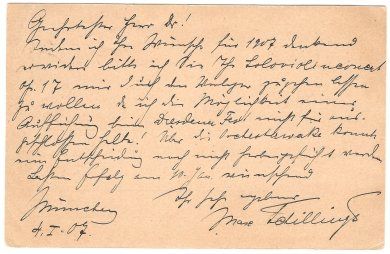Jean Paul Ertel
Jean Paul Ertel was born 22.01.1865 in Poznan. He had his first piano lessons with Louis Brassin and composition studies with Julius Tauwitz in Poznan and in 1886 became a pupil of Franz Liszt in Weimar. Liszt once said about Ertel that "he can passably play the piano, but achieve outstanding results in his compositions without question." Nonetheless he studied jurisprudence in Berlin and did a doctorate in it in 1896. For a few years Jean Paul Ertel earned his living as a jurist, but his passion was dedicated to music. He later taught music privately and as a lecturer at smaller conservatories, and worked as a music critic for different newspapers in Berlin. Beside that he composed orchestral and chamber music and his music was championed by such famous conductors as Arthur Nikisch, Gustav Mahler, Felix Weingartner, Ferdinand Loewe or Richard Strauß in the early 20th century. Especially his symphonic poems were often performed during the 1910s and 20s. Jean Paul Ertel died on 11.02.1933 in Berlin.
Also, the Concerto for violin alone op.17, was quite famous in Germany in the 1910s and 20s. The piece was famous, first because Paul Ertel was a distinguished composer, but second for being one of the most difficult violin pieces ever written up to that point in time. Furthermore, it contains a four-part fugue on the four strings and so is also a curiosity in the violin literature. So on the whole the Concerto for violin alone by Paul Ertel is a most interesting and unique composition.
The violin concerto had renowned advocates from the very start. It was premiered on 7 January 1907 by Alexander Sebald. The Hungarian violinist was one of the most distinguished performers at that time. But also Max von Schillings, for example, another famous composer and conductor in the early 20th century, requested the score of the violin concerto right before the world premiere, as the postcard on the right shows:
Postcard from Max von Schillings to Paul Ertel from 4 January 1907. Max von Schillings wrote:
"I would also ask you to have your publisher send me your solo violin concerto op.17, as I think there may be a possibility of performing it at the Dresden festival!"
After the premiere, the concerto at first received a devastating review in the "Neue Zeitschrift für Musik":
"A piecemeal conglomeration of boring and repulsive cadences and chords. Without consideration of the concertante technique of the solo instrument, the work demands a tonally unaesthetic result that is not at all rewarding."
But it didn't take very long to find supporters for the work. Just a few weeks after the premiere the following review was published again in the "Neue Zeitschrift für Musik" accompanying the publication of the score by Bote & Bock:
"I consider the one-movement concerto by Paul Ertel as a very interesting experiment, the rewards of which are inversely proportional to the immense difficulties for the performer. The reason for this conclusion is not for the weakness of the ideas but for the poor organization, or in other words, poor style of the composition.
While in his works for solo violin, S. Bach emphasizes the melodic and contrapuntal elements (both clearly recognizable even in pure passage work), and thereby allows a wide variety of movement and expression, Ertel over-emphasizes precisely the weakest aspect of the violin, namely the harmony. Therefore, the violin texture becomes viscous, an effect that prevents freedom of movement and even of thematic work. Moreover, the musical sound is in danger of being muddied by even the slightest intonation problem that could question the harmonic structure and euphony at the same time. Only violinists with an unchallengeably reliable, brilliant technique may expect to master the exceptionally difficult work with success."
And in 1911 a performance of the concerto by Julius Ruthström, another famous violinist, was reviewed:
"It was stimulating to listen to the interesting g-minor concerto for violin by Paul Ertel yet again."
Another reviewer noted:
"Paul Ertel introduced himself with a concerto in one movement for solo violin, which isn't a particularly good idea due to the limited possibilities of the instrument. This point notwithstanding, the composition showed much musical beauty, testimony to the composers intimate knowledge of the instrument and his significant mastery of texture which culminates especially in contrapuntal intricacies."
And even in the 1920s such distinguished violinists like Florizel von Reuter were attracted by the composition:
On the right: A postcard from Florizel von Reuter to Paul Ertel from 1921, in which the violinist mentioned:
"In the last days I vehemently struggled with your violin concerto, and with good success, as I now have the piece nearly ready to perform - and also by heart!"
After the death of Jean Paul Ertel in 1933 his compositions disappeared from concert stage including the Concerto for violin alone op.17.
(I would like to thank composer Elizabeth Vercoe and violinist Simon Smith for helping me with the translation of the reviews and for making this text proper English - Thank you!)


